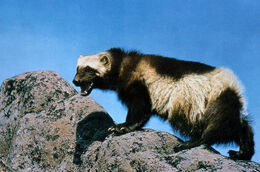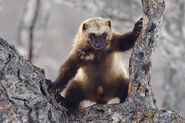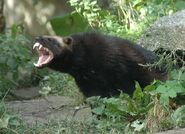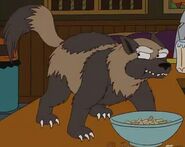
Wolverine on rocky terrain
The wolverine (Gulo is Latin for "glutton"), also referred to as the glutton, carcajou, skunk bear, or quickhatch, is the largest land-dwelling species of the family Mustelidae (weasels). It is a stocky and muscular carnivore, more closely resembling a small bear than other mustelids. The wolverine, a solitary animal, has a reputation for ferocity and strength out of proportion to its size, with the documented ability to kill prey many times larger than itself.
The wolverine is found primarily in remote reaches of the Northern boreal forests and subarctic and alpine tundra of the Northern Hemisphere, with the greatest numbers in northern Canada, the US state of Alaska, the Nordic countries of Europe, and throughout western Russia and Siberia. Its population has steadily declined since the 19th century owing to trapping, range reduction and habitat fragmentation. The wolverine is now essentially
absent from the southern end of its European range.
Physical Characteristics[]
Anatomically, the wolverine is a stocky and muscular animal. With short legs, broad and rounded head, small eyes and short rounded ears, it resembles a bear more than other mustelids. Though its legs are short, its large, five-toed paws and plantigrade posture facilitate movement through deep snow.
The adult wolverine is about the size of a medium dog, with a length usually ranging from 65–107 cm (26–42 in), a tail of 17–26 cm (6.7–10.2 in), and a weight of 9–25 kg (20–55 lb), though exceptionally large males can weigh up to 32 kg (71 lb). The males are as much as 30% larger than the females and can be twice the females' weight. Shoulder height is reported from 30 to 45 cm (12 to 18 in). It is the largest of terrestrial mustelids; only the marine-dwelling sea otter, the giant otter of the Amazon basin and the semi-aquatic African clawless otter are larger, while hog badger may reach a similar size.
Wolverines have thick, dark, oily fur which is highly hydrophobic, making it resistant to frost. This has led to its traditional popularity among hunters and trappers as a lining in jackets and parkas in Arctic conditions. A light-silvery facial mask is distinct in some individuals, and a pale buff stripe runs laterally from the shoulders along the side and crossing the rump just above a 25–35 cm (9.8–13.8 in) bushy tail. Some individuals display prominent white hair patches on their throats or chests.
Like many other mustelids, it has potent anal scent glands used for marking territory and sexual signaling. The pungent odor has given rise to the nicknames "skunk bear" and "nasty cat." Wolverines, like other mustelids, possess a special upper molar in the back of the mouth that is rotated 90 degrees, towards the inside of the mouth. This special characteristic allows wolverines to tear off meat from prey or carrion that has been frozen solid.
Behavior[]
Diet and Hunting[]
The wolverine is a powerful and versatile predator and scavenger. Prey mainly consists of small to medium-sized mammals, but the wolverine has been recorded killing prey such as adult deer that are many times larger than itself. Prey species include porcupines, squirrels, beavers, marmots, rabbits, voles, mice, shrews, lemmings, caribou, roedeer, white-tailed deer, mule deer, sheep, moose, and elk. Smaller predators are occasionally preyed on, including martens, mink, foxes, Eurasian lynx, weasels, and yote and wolf pups. Wolverines have also been known to kill Canadian lynx in the Yukon of Canada. Wolverines often pursue live prey that are relatively easy to obtain, including animals caught in traps, newborn mammals, and deer (including adult moose and elk) when they are weakened by winter or immobilized by heavy snow. Their diets are sometimes supplemented by birds' eggs, birds (especially geese), roots, seeds, insect larvae, and berries. A majority of the wolverine's sustenance is derived from carrion, on which they depend almost exclusively in winter and early spring. Wolverines may find carrion themselves, feed on it after the predator is done feeding (especially wolf packs) or simply take it from another predator. Whether eating live prey or carrion, the wolverine's feeding style appears voracious, leading to the nickname of "glutton" (also the basis of the scientific name). However, this feeding style is believed to be an adaptation to food scarcity, especially in winter.
Armed with powerful jaws, sharp claws, and a thick hide, wolverines, like most mustelids, are remarkably strong for their size. They may defend kills against larger or more numerous predatorssuch as wolves or bears. At least one account reported a wolverine's apparent attempt to steal a kill from a black bear although the bear won what was ultimately a fatal contest. In another account, a wolverine killed a polar bear. Wolverines are known to follow wolf and lynx trails, purportedly with the intent of scavenging the remains of their kills. Wolves are thought to be their most important natural predator, with the arrival of wolves to a wolverine's territory presumably leading the latter to abandon the area.
Wolverines inhabiting the Old World (specifically, Fennoscandia) hunt more actively than their North American relatives. This may be because competing predator populations in Eurasia are not as dense, making it more practical for the wolverine to hunt for itself than to wait for another animal to make a kill and then try to snatch it. They often feed on carrion left by wolves, so changes in wolf populations may affect the population of wolverines. They are also known on occasion to eat plant material.
Wolverines frequently cache their food during times of plenty. This is of particular importance to lactating females in the winter and early spring, a time when food is scarce.
Mating and Reproduction[]
Successful males will form lifetime relationships with two or three females, which they will visit occasionally, while other males are left without a mate. Mating season is in the summer, but the actual implantation of the embryo (blastocyst) in the uterus is stayed until early winter, delaying the development of the fetus. Females will often not produce young if food is scarce. The gestation period is 30–50 days, and litters of typically two or three young ("kits") are born in the spring. Kits develop rapidly, reaching adult size within the first year of a lifespan that may reach anywhere from five to (in exceptional individuals) 13 years. Fathers make visits to their offspring until they are weaned at 10 weeks of age; also, once the young are about six months old, some reconnect with their fathers and travel together for a time.
Distribution[]
Wolverines live primarily in isolated arctic and alpine regions of northern Canada, Alaska, Siberia, and Scandinavia; they are also native to European Russia, the Baltic countries, the Russian Far East, northeast China and Mongolia. In 2008 and 2009, wolverines were sighted as far south as the Sierra Nevada, near Lake Tahoe, for the first time since 1922. They are also found in low numbers in the Rocky Mountains and northern Cascades of the United States, and have been sighted as far south and east as Michigan. However, most New World wolverines live in Canada.













